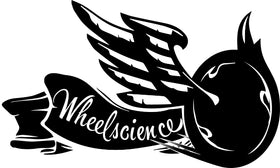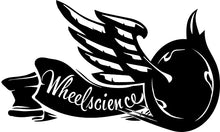Wheel selection and race day preparation
At Wheelscience, we take care of the technical details, which means by race day, all you need to understand is that your wheels make you faster. Welcome to the ‘Wheelscience quick guide to race wheels’.
We are going to cover:
- Wheel selection
- Clinchers v tubulars
- Tube selection
- Tyre selection
- Tyre pressure
- Race day prep
Wheel selection
The table below indicates the time savings you can expect using our wheels (or other wheels of a similar rim profile). The table shows rim depth (in mm) on the left and time saving (by distance) in the subsequent columns.

The above data was gathered using the alfamantis system at the DISC velodrome in Melbourne, Australia. Tyres used were 23mm GP 4000 s 2 and were inflated to 100psi. Tubes were continental butyl.
Our recommendation is that you ride as deep a rim as you are comfortable on, given conditions. Please note we say “you are comfortable on”. If deep rim wheels make you nervous, or you don’t like them, don’t ride them! If you want any more advice on this, please feel free to get in touch and we will happily discuss the right selection for you.
Clinchers or tubular tyres
Wheelscience recommend using clincher tyres. Why? Well, the technology in clinchers has advanced so much that the performance benefit of tubulars has been totally eroded for time trialling. Clinchers are a lower cost to maintain and easier to change, so with no performance benefit, we cannot see a reason to go for tubulars. Also, be aware that a bad ‘glue job’ on your tubulars can actually add more rolling resistance to the wheel!
Note that for climbing, where weight is everything, tubulars can still come out on top in some circumstances.
Tube selection
Given we recommend using clinchers, we better also let you know our thoughts on tubes. You have three real choices
- Cheap butyl (rubber)
- “Expensive” butyl (rubber)
- Expensive Latex/other higher tech material
We can never recommend buying cheap tubes. They are more prone to quality problems, weigh more and give you a higher rolling resistance than either a better butyl tube or latex. So please don’t risk your race and your performance for the sake of a few dollars.
However, we also do not believe that you need to spend all your hard earned cash of tubes that cost a fortune! While Latex tubes are lighter and offer great performance, they are famously fragile. They also require constant topping up as they leak more air through the walls than other tubes. Try typing “problems with latex tubes” into google!
We recommend the use of a good quality, brand named, inner tube for the perfect balance of price, performance and longevity.
Tyre selection
There are so many tyre options around. But don’t worry; after years of racing and training we have the answer! The Wheelscience recommendation for tyres is ………. Conti GP4000 s 2. They offer the perfect balance of performance and puncture resistance. We have no affiliation with Continental, we just love products that deliver what they promise day after day.
What about tyre width ? Our wheels will accept any tyre width from 21mm to 28mm. The latest research shows that a wider profile leads to lower rolling resistance, however this can be at the expense of aerodynamics. The interaction between the wheel, the tyre and the bike is incredibly complex. Also you may need to take into account that some bikes have very limited frame/wheel clearance and so cannot take the wider sizes.
So how do we make this simple? Given the lack of conclusive evidence we leave you a choice of two. The use of a 23mm tyre will optimise your aerodynamics with our wheels while a 25mm may reduce your rolling resistance. The choice is yours.
Tyre pressure
Did you know your tyre is an incredible feat of engineering? So it is a shame to undo all that good work by getting your pressure wrong. The biggest error people make is to put TOO MUCH pressure in their tyres, which can seriously impact performance and handling. Luckily we have some great simple rules to help you make the right tyre pressure decision.
- Never ignore the minimum or maximum pressure stated on the side of the tyre!
- If you are using a 23mm tyre, take your weight in kgs and multiply by 1.5 to get your psi.
- If you are using a 25mm tyre, take your weight in kgs and multiply by 1.3 to get your psi.
- If the road surface is rough, adjust to 5-10 psi lower (10 for very rough). This will allow your tyre to roll over the bumps faster and also reduce vibrations which may impact you; ouch!
- On a wet day consider 5 psi less, for more grip.
Race day prep
Here are some handy tips to help race day go off without a hitch (from your wheels!)
- The day before the race check the wear levels on your brake blocks.
- Check your tyres for glass or other objects. Do this the day before, by deflating your tyre and working your way around it, pinching it between you thumb and finger. This will open up any small splits or holes, meaning you can thoroughly check the tyre.
- Check your tyre pressure (as the first thing you do before setting everything up). That way you are not climbing around your carefully set up transition area, to do it last!
- Dust off your tyres when you have checked the pressure, just use a cloth or similar.
- Spin your wheels to make sure nothing is rubbing.
- Have an awesome race!



